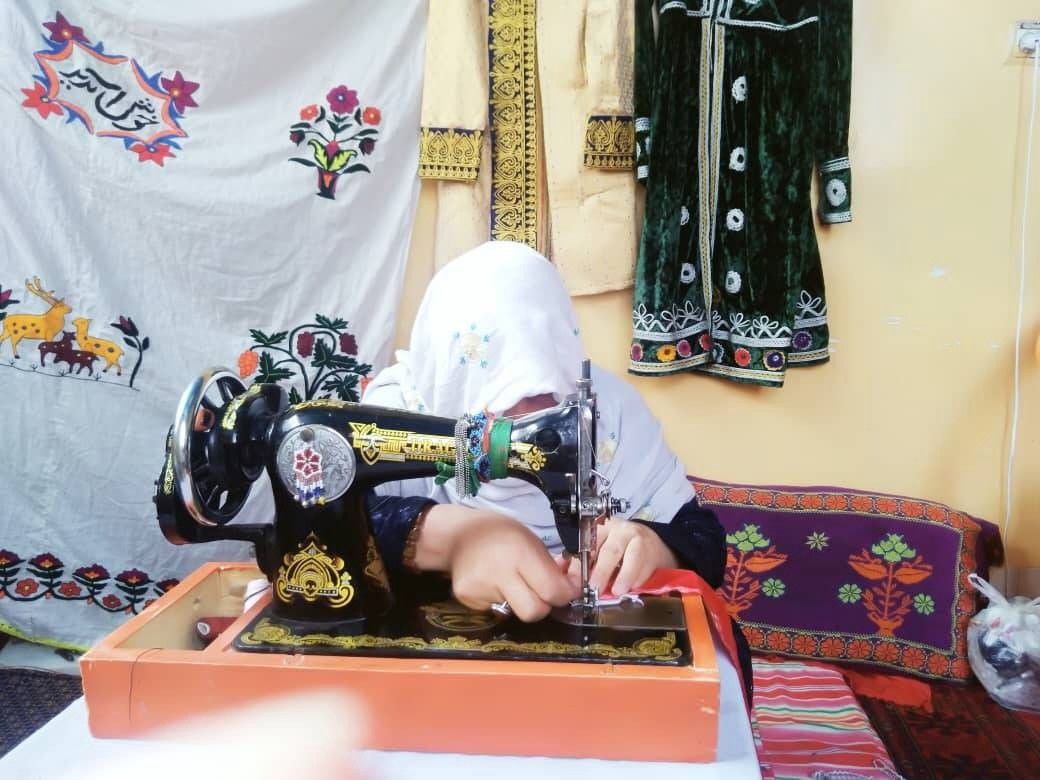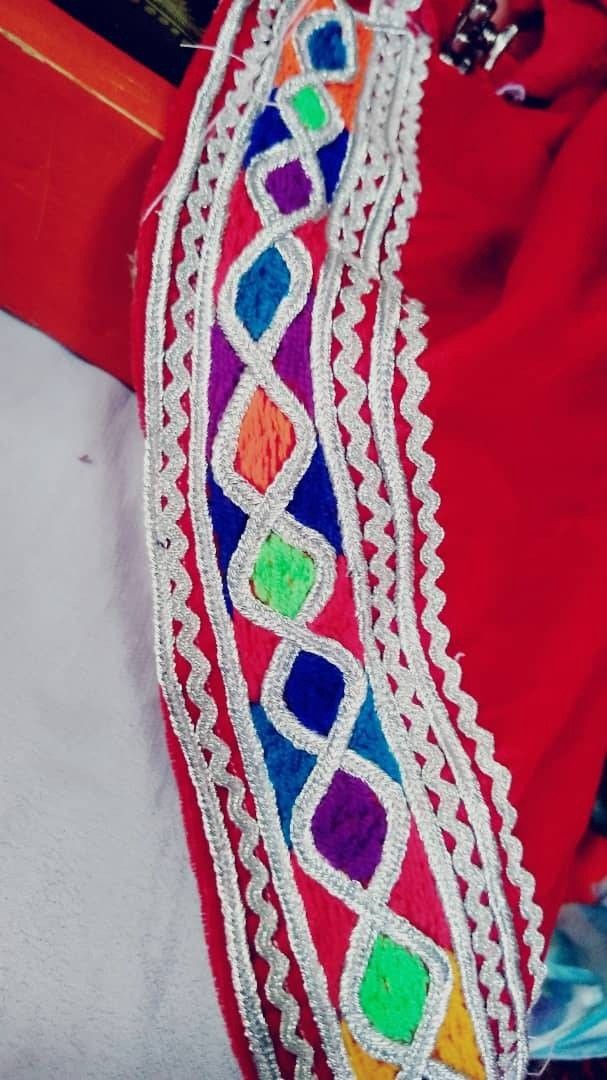Hard Work, Lost Hope of an Afghan Embroiderer

— One Day in Afghanistan —
Reporting by Fatima Ehsani, edited by Mohammad Jawad and Brian Conley
It’s close to 8 am now and I am sitting in 45 year-old Ms. Maryam Sulaimani’s home in Feroz Koh, the capital of the province of Ghor, 400km west of Kabul.
Ghor is one of the most isolated provinces located in Afghanistan’s northwest and best known for the 12th century Minaret of Jam. A mountainous province with a population of about 700,000, Ghor borders Herat on the west and Bamiyan to the east. The population has been affected not only by the continuous war, but since its primary economy is agriculture and livestock, recurring years of drought has created a chain of ongoing displacement.
Maryam Sulaimani is an embroiderer whose profession is the primary way she feeds her family. Her 56 year-old Husband, Nader Jan, is a laborer and they have five kids. Suhaila, Maryam’s oldest daughter is 20, Hamid is 19, Rahila is 16, Khadim is 13 and Mubaraka is 11.
Cherma Dozi, a variation of embroidery, is famous in Ghor province. According to Ms. Sulaimani, girls in Ghor would wear embroidered scarves, hats and vests. The tradition was such that girls that deemed themselves more stylish would wear outfits with beautiful embroidery all over.
This tradition came into style again in the past decade, with different, more modern designs,” Maryam says, adding that in the previous years, people would only have embroidery on their dress, but recently people do embroidery on overcoats and all types of wearables.
Maryam begins work every day around 8 am and ends it between 4:30 to 5 pm, if she has a larger order, she works until 10 pm. She lives in a three room house her family owns, they use one for the guest room, one for living and sleeping and the other for her workshop. They have a hallway which is partially used as a kitchen.
Ms. Sulaimani, who transitioned to this style of embroidery some three years ago, says she profited about 8,000 to 10,000 Afghanis ($88 to $111) per month before the collapse of the western backed Afghan government but now can only profit about 5,000 Afghanis ($55). She hopes her job can pick up again.
“I had helpers working for me before the Taliban takeover but they have all left the province now,” Maryam says, adding that she will hire helpers again if her workload increases.

Only two of her kids, Khadim and Mubaraka, currently go to school. “I am concerned that two of my daughters don’t get to go to school anymore,” Maryam says.
“I made all this effort and worked hard so my daughters do not have the same life as me in the future. I was happy that Suhaila finished school this year and will get to go to university. I hope schools restart again so Suhaila can go, otherwise my husband is thinking to marry her to her cousin, although Suhaila doesn’t want to do that. Suhaila is 20 while her cousin who works in Iran as a laborer and is illiterate, is 30 years-old.”
“People order dresses for their reception or wedding night, as well as for the groomsmen and bridesmaids. Previously, foreigners, school choir teams and government employees would all order embroidered chapans.”

She learned Cherma Dozi from her mother when she was young. According to her, her transition to Cherma Dozi from Gul Dozi, her previous profession, is because, as she says, “I saw a school choir team on TV about three years ago, they were wearing clothes with Cherma Dozi on them and I liked it so I made the decision to become a Cherma Doz. After starting this profession, I was invited to showcase my products at a ceremony in the women’s garden here in Feroz Koh. I sold some hats there and my work picked up from there.”
Ms. Sulaimani enjoys her work very much, especially when she is making different patterns and designs. “If I was literate, I would be an artist. Work with a hand-operated sewing machine is slow and tedious.”
Maryam earns 300 to 600 Afghanis per day ($3 to $6), but according to her, this amount changes seasonally. Maryam categorizes her price list by the items hanging from her wall as below.
1. I charge 1200 Afghanis ($13) for the Chapan with the yellow embroidery;
2. 1500 ($16) for the red Chapan that has a combination of embroidery by hand and sewing machine, it took four days to make that;
3. 800 ($9) for the black coat, which is for an old customer; and
4. 400 ($4.30) for the blue dress.
During Eid, Ms. Maryam works from 7 am to 10 pm, she would only do the embroidery and let her helpers do the rest — when she had helpers.
Feroz Koh, the capital of Ghor province does not have a central grid, the power is provided by generators that charge 42 Afghanis ($0.47) for each kilowatt of electricity, which has also been out for the past few days due to technical issues.
“I work during the nights because I cannot afford to buy and run a personal generator and do not have electricity during the day.” She uses solar energy for the house and lights but that is not enough to power the sewing machine, therefore she must make the orders by hand-operated sewing machine.

Each day Maryam wakes up early in the morning and prepares dough, her daughter Suhaila then cooks the bread in a gas powered oven, then they eat breakfast, and everyone gets busy with their own duties. When girls’ schools were open, Suhaila would go to school while Maryam sweeped the house, but now Suhaila performs those duties as she doesn’t have anything else to do. Maryam begins her embroidery work after breakfast.
“When I have guests occasionally, I spend time with them and the girls cook, other than that I work and the girls take care of our home or the chores associated with it.”
Today Ms. Sulaimani is making a dress for Farida, one of her customers. She first gets her measurements.
“Auntie Maryam, please finish my dress by the end of the week, I am going to my dad’s house on Friday,” Farida requests Maryam. Maryam assured her that the job will be done on time, then took the piece of red velvet cloth and started drawing on the piece of cloth with a pen. She then began embroidering the cloth Farida brought. She talks with me while working.
“If my workload is high during Eid and new year, I use the electric sewing machine at night but do the embroidery with the hand-operated sewing machine because an electric sewing machine cannot do a proper job on such kind of embroidery.”
The time now is 12:15, Ms. Sulaimani puts the piece of cloth on the other side, stretches and tells me to accompany her to the other room so we can eat lunch and pray. We leave the workshop together and enter the guest room. Her daughters enter and we are introduced. Rahila brings the Ab Dast, we wash our hands and Mubaraka lays out the linen we will eat on. Two pieces of bread are now on the linen and Rahila brings in two large plates of Kichiri. Mubaraka brings yogurt and glasses. Maryam asks Rahila and Mubaraka to join us while asking Suhaila to take food for her dad and brothers.
We talk as we eat, Ms. Sulaimani thanked God and said, “The girls are now older and can take care of all the chores at home, especially now that there is no school for the older ones. I can just pay attention to my work.”
The Kichiri, which is a delicacy in Ghor, is made of rice, mung beans, and yogurt, was wonderful. During the winter, people add Landi (dried meat) to the dish to make it more delicious.
We eat and then pray. The time is now 2 pm and Ms. Sulaimani and I return to her workshop. Another customer, Nasima Rezai, enters her workshop and orders a traditional dress for her daughter.
“We are attending a wedding tomorrow evening so you must finish by then,” Nasima tells Maryam while requesting to see the catalogue of designs she has. However Maryam has no catalogue, the designs she uses are all made by her, with her phone she shows the customers photos of different designs to choose from, sometimes the customers bring their own design. Ms. Rezai chose a design and asked how much it would cost.
“800 Afghanis for others but since you are an old customer, 700,” Maryam tells Nasima, Nasima started bargaining saying she will only pay 500, but Maryam says, “I will take 600 just because of your beautiful daughter.” The customer thanked her and left.
“Please bring me a glass of tea,” Maryam tells one of her daughters as the clock nears 2:45 pm. After a few minutes Rahila entered with a pot of green tea and three glasses. She poured one for me, and the other for her mom.
Rahila then asked if I had gone to university and I said yes, she then asked in this province or outside, and I told her I studied in Bamiyan. Rahila, who had heard stories from friends about university and the time in dorms, sighed and said, “That sounds really good, my uncle’s daughter studied in Herat and lived in a dorm. She used to tell me stories about the university, her friends and living in a dorm all the time, raising my interest in studying and making friends in a university; but it is very sad that even schools are now closed for us.”
Rahila’s comments affected me, I could only tell her to be strong and she will achieve her dreams. She smiled and went away.
Maryam continued working but her daughter’s comments left a deep concern on her face, “I am heartbroken that girls cannot go to school, there was a lot of misogyny in Ghor in the past as well, but it has now increased. The uncertain future of Suhaila and Rahila hurts me deeply. I follow the news every night in the hopes of girls’ schools reopening, but am yet to hear any good news.”
Ms. Maryam is upset about her husband’s opinion about education for girls and says, “My husband says the Taliban did a great thing by telling women not to work and girls above 6th grade not to go to school. The best thing for girls is to learn how to cook so they can live in their husbands homes with honor. This comment by my husband is very hard to swallow for my girls and I. I wish an inclusive system will again be in control so women and girls’ are not constrained by the burka and locked in the corner of their homes.”
Maryam is very upset about the fact that she works non-stop, but her husband gets to make all the decisions, she says, “It got a little better during the previous government, but the mentality of male domination is growing again.”
She keeps drinking tea while working and shows me her customers’ orders one after the other. The embroidery that she has made with utmost care and elegance keeps the eye locked on them, it is like her needle is made of gold.
When Maryam does not have any orders, she makes her own dresses with different designs to sell. One of the dresses hanging from her workshop wall has piqued my interest.
“How many days have you worked on that and what does it cost?” I ask.
“Three days and it’s 1,200 Afghanis,” Maryam says.
It is now 4:30 pm and Maryam looks tired. She collects her equipment slowly and marks the day as done.
